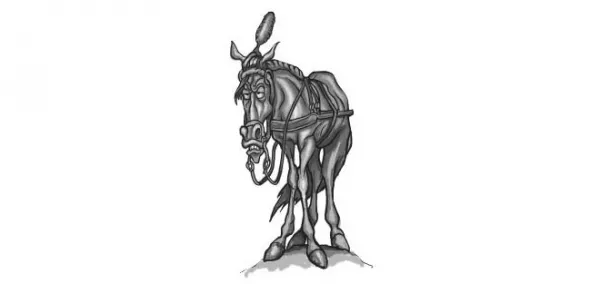
It was with considerable dismay that I read about Jerry the carriage horse who collapsed on State Street last Saturday morning. The photos of Jerry lying on the hot pavement, and the accounts of the traumatized and bleeding Jerry being hoisted by a forklift and transported to an animal hospital, evoked an outpouring of outrage at the deadening paces Jerry and his mates are put through for the amusement of a small number of carriage riders.
On the same day that Jerry nearly died, a newspaper story reported on the resurgent squalor of the city’s homeless population. In their own ways, the unemployed homeless and the working carriage horses have been largely taken for granted. Both the horses and the homeless are fixtures of urban life, ignored except when they get in our way as we go about our own business.
One difference is that the horses, despite their abusive working conditions, at least appear to be well-fed, and better cared for than the ragged homeless population. That’s not saying a lot, but on the other hand, maybe it’s saying a great deal.
In any event, I wanted to get a broader perspective on both the abused horses and the squalid homeless. I spoke with Dr. Aldeni Ensernos, who holds the Laputa Endowed Chair at the Academy de Lagado in Portugal. An expert in urban anthropology, Dr. Ensernos is currently spending a sabbatical at Snow College, where he is also lecturing on animal husbandry.
Here is an excerpt from our recorded telephone conversation.
Deep End: Did you happen to catch the story of Jerry the carriage horse?
Dr. Ensernos: Heartbreaking, for sure. We had a horse named Jeorzi, pronounced horsie, when I was a kid on the farm just south of Guimarães. In Portuguese, as you know, we call horses “houyhnhnms,” and the idea of making them pull a carriage full of yahoo tourists or horny newlyweds around the block all day, in the broiling sun, in clouds of poisonous automotive exhaust, makes my blood boil, just like poor Jerry’s boiling blood in your city of Zion.
D.E.: But they get water and tasty treats.
Dr. E.: Would you pull a carriage around all day in record-breaking temperatures just for water and a yummy treat?
D.E.: Another question. Did you read the story about how the homeless are starting to take over Pioneer Park again, despite the Farmers Market and loud concerts on summer nights?
Dr. E.: Disgraceful how your wealthy, very richy nation cannot feed the poor and house the homeless. All that abundance of fruits and vegetables and ethnic culinary concoction on Saturdays and hungry homeless folks every other day of the week make for a thought-provoking contradiction.
D.E.: You are world-famous for your indefatigable efforts to improve the human condition through innovative schemes and projects. How would you propose to solve the seemingly intractable evils of horse abuse and homeless squalor?
Dr. E.: My proposal is modest, but in all humility, I do not see how any rational and compassionate yahoo, I mean human being, could find any objection to my scheme, which is as follows: We replace the carriage horses with able-bodied homeless people. Already they have been forced to endure extremities of environment—freezing nights, boiling days, noxious fumes of vehicles in the vicinity of freeway exits. Already they have developed admirable upper body strength by holding up signs expressing their desire for work. This upper-body ability is well suited for pulling carriages of two, four or even six humans.
I have computed commensurate ratios of horsepower versus human power, and conclude that four able-bodied homeless males could do the work of one horse, or three able-bodied males assisted by three comparatively able-bodied females could do the equivalent work of 1.5 horses. To the objection that great expense would be necessary to provide the requisite attire for the carriage pullers, I would point out that those colorful horse hats, with hole for the ears to stick out of, would fit the bill entirely, with the holes providing needed ventilation. Also, for people uneasy with humans pulling them instead of horses, the horse hats would serve as transitional objects to ease their guilt.
D.E.: Will the idea catch on?
Dr. E.: No one else has proposed a workable plan to help the homeless. And to answer the charge that I may benefit from this scheme, let me point out that I am not homeless, having a nice furnished room near campus.
D.P. Sorensen writes a satire column for City Weekly.